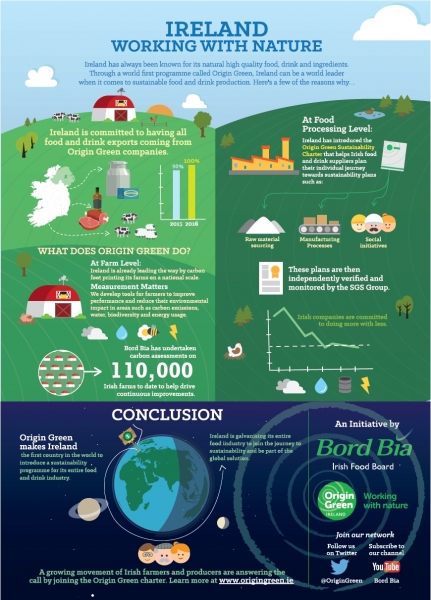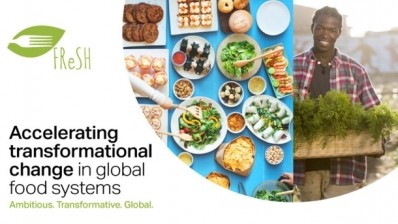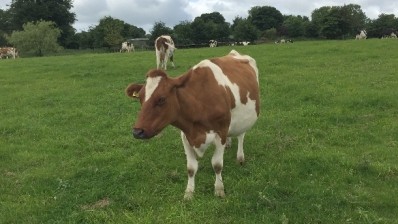spotlight on Ireland
Ireland – aiming to become a world leader in sustainability with Origin Green
This content item was originally published on www.dairyreporter.com, a William Reed online publication.
With the global population expected to rise by 2.4bn before the year 2050, the world will need to produce up to twice as much food from increasingly limited resources.
To meet some of the challenges involved, in 2012 the Irish Food Board, Bord Bia, launched Origin Green, the first national sustainability program of its kind.
Lowering carbon footprint
The Irish Government set out a strategy for Ireland’s globally-focused food industry through Food Harvest 2020.
A key element of the sustainability pillar of this strategy is Origin Green, which aims to have every farm and food manufacturing business in Ireland working to lower their carbon footprint annually, while playing a proactive role in the wellbeing of their local environment.
Independently verified at every stage, the voluntary program sees food manufacturers develop a plan that defines clear targets in key areas of sustainability, such as raw material sourcing, emissions, energy, waste, water, biodiversity and social sustainability.
Origin Green
- 507 Irish food and drink companies registered with Origin Green
- 180 Origin Green verified companies representing over 85% of exports
- 100,000 carbon footprint assessments have been undertaken
Dairy expansion
As dairy quotas were lifted on April 1, 2015, the Irish dairy industry is facing an unprecedented level of expansion over the next five years. With over €1bn ($1.1bn) being invested on dairy farms and over €600m ($658m) in processing and market capacity, Bord Bia says that the Irish dairy industry will have the fastest growing dairy sector in the world over the next five years.
However, Bord Bia is confident this expansion will occur in a sustainable manner thanks to the Origin Green program implementation, and the introduction of the new national dairy farm standard, the Sustainable Dairy Assurance Scheme (SDAS), in 2013.
The SDAS encompasses both quality assurance and sustainability that measures the carbon footprint of each individual dairy farm. Currently 80% of farms are participating in this scheme.
Irish dairy industry facts
Irish dairy exports reached €3.24bn ($3.57bn) in 2015, and continue to rise. In 2014, there was a 30% increase to Asia, two-thirds of which was for the Chinese market.
By 2020, dairy production is expected to grow by 50%.
China is Ireland’s second most important export market for dairy products, behind only the UK.
In spite of only having 1% of the world’s dairy production, the country supplies 10% of global infant formula.
Average herd size is 60 cows.
Average production is 300,000 liters, with a yield per cow of approximately 5,000 liters.
National milk production is approximately 5.4bn liters.
Following abolition of quotas, Irish milk supplies were 11% (600m liters) higher in the first ten months of 2015.
Ireland exports to 130 countries.
42% of Irish dairy exports were to countries outside of the EU in 2015.
Farm visits
More than 100 independent auditors visit farms each day to measure the environmental impact of each production system using the Carbon Navigator tool in a process of measurement, feedback and continuous improvement.
At farm level, Bord Bia has undertaken over 100,000 carbon footprint assessments on a national scale, a world first.
Each farm is measured against six efficiency measures with the aim of lowering the environmental impact of the farm but also providing greater profit margins for the farmer.
Progress reports
As part of Origin Green, the timelines and targets companies set are captured within sustainability plans that are verified to an independent standard. To become a verified member of the Origin Green program, producers must undergo a verification process.
Each verified member must submit an annual progress report that assesses the impact and progress of the individual company.
Profitability linked to reducing carbon footprint
Joe Hayden, who has a 160-cow dairy farm near Tinahely, in County Wicklow, follows the progress through regular meetings with other farmers, and works to ensure that his report shows positive progress on an annual basis.
Hayden told DairyReporter that farmers around the world have to deal with paperwork, and with Origin Green it’s no different, but the results speak for themselves.
“The Origin Green program is different in that it directly links profitability with reduction of the carbon footprint. In the Carbon Navigator we have a tool that allows us to use basic management issues around days of grass, energy efficiency, economic breeding index of the cows, to actually increase the profitability of the farm.”
Value of discussions
With respect to the cow breeding, Hayden says that they have been trying to breed cows that are more efficient at turning grass into milk solids.
“On this farm, six years ago, the average butterfat was 3.8%, the average protein was 3.25. In 2015, those figures were 4.1% butterfat and 3.5 protein,” he said.
“This in economic terms is worth €20,000 ($22,000) to milk sales on the farm. These are economic issues that can benefit the farm. We’re not just focused all the time on the price of the milk outside the farmgate.”
Hayden told DairyReporter that dairy discussion groups - monthly meetings that are held with other local farmers – have been invaluable.
“We have a professional facilitator from Teagasc, which is the research and training authority in agriculture here in Ireland, and this guy would be responsible for taking the latest information regarding efficient dairy production and help to optimize the efficiencies of our business and transferring that information back into the group.
“It has been a very effective system of helping us to grow and develop the efficiencies of our business.”


























